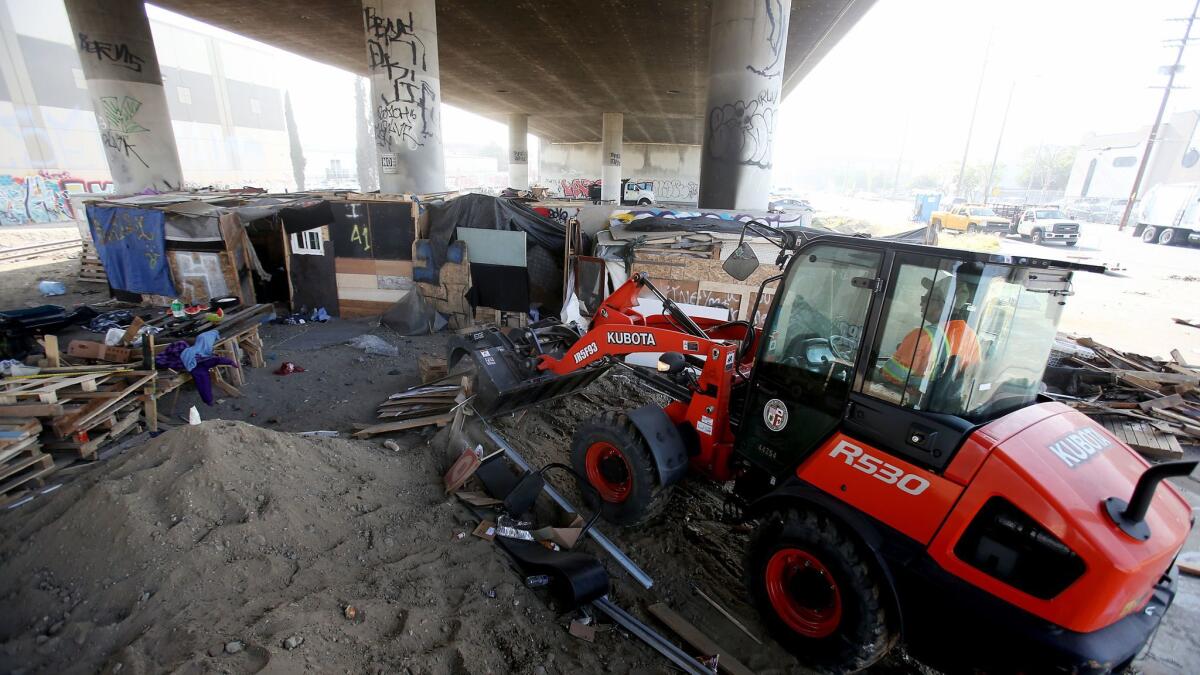Absentee vote pushes L.A. County homeless sales tax measure to a strong finish

- Share via
Ten days after the election, a measure to raise the sales tax a quarter-percent to fund homeless programs across Los Angeles County was declared a winner Friday with a growing margin over the required two-thirds majority.
After counting the last 55,000 ballots, the Los Angeles County Registrar-Recorder reported Friday afternoon that the yes vote for Measure H had climbed to 69.24%.
“It’s a great day for Los Angeles,” said Mayor Eric Garcetti. “It’s a great day for people who have waited for something big to come and finally can see a model that can work. Now we have to make it work.”
Added to the half-cent transportation tax approved by voters in November, the measure will increase the sales tax rate to 9.5% across most of the county in July.
It is expected to raise $3.5 billion over a decade and launch what officials have characterized as the most comprehensive homelessness program ever attempted in the county.
Combined with the $1.2-billion housing bond approved by Los Angeles city voters in November, it will get 45,000 of an estimated 47,000 homeless people in the county off the streets in five years, according to predictions.
The Measure H money will provide rental subsidies for homeless people as well as case management and mental health services to help them stay housed. Also set to receive funds are initiatives that would, for example, remove homeless people from the justice system and prevent others from becoming homeless.
“Thank God for the people of L.A. County who took matters into their own hands and opened their hearts in a way that said this vote will be governed by compassion, prudence and wisdom,” said Mark Ridley-Thomas, chairman of the Board of Supervisors.
The early declaration of victory last week by some leaders of the Measure H campaign — with almost a third of the vote still uncounted — reflected their expectation that a final pre-election push had brought out thousands of yes voters.
The county’s two major charitable organizations, United Way of Greater Los Angeles and the California Community Foundation, enlisted supporters from more than 300 organizations to reach out to voters.
Meanwhile, fundraising spearheaded by Ridley-Thomas, the Los Angeles Area Chamber of Commerce and the Los Angeles County Federation of Labor poured $3.5 million into mailing and advertising.
It’s a great day for Los Angeles. It’s a great day for people who have waited for something big to come and finally can see a model that can work.
— Eric Garcetti, mayor of Los Angeles
In a separate campaign, the Los Angeles County Chief Executive Office spent $1 million for outreach including television spots that highlighted Measure H. The Board of Supervisors authorized the spending “to inform voters with a fair presentation of the facts.”
The ads, which were characterized as educational rather than electioneering, showed homeless people either in the streets or newly housed. They finished with the message: “Measure H on the March 7 ballot. LA County Homeless Initiative. Real Help. Lasting Change.”
The registrar-recorder reported that records dating back to 1902 showed that Measure H was the only revenue proposal ever attempted during a March election, when generally low turnout poses an obstacle, especially in an era of supermajority requirements.
Despite the 77% margin city voters handed the Proposition HHH bond in November, success was far from certain.
Campaign strategists warned that the low turnout expected in a March countywide election would disproportionately draw older and more conservative voters less likely to favor a tax increase.
The team that led Proposition HHH to victory had to come up with an entirely new strategy for Measure H, said Tommy Newman, who coordinated the different groups involved in the campaign.
“On the HHH campaign, we knew the voters would be there,” Newman said. “For the H campaign, we needed to make sure the right people voted and that we got the message to those people.”
The campaign mailed more than 4 million pieces of literature and advertised in newspapers, including the front page of The Times. Political strategist Steve Barkan of SG&A Campaigns said ads placed online appeared on pages viewed 11 million times.
Barkan said Measure H was polling at 65% to 66% in late polls, “but undecideds clearly broke toward a ‘yes’ vote, and supporters were more motivated to turn out to vote.”
Those voters were then targeted by mail, online and in person. To reach them in person, the California Community Foundation, which committed $300,000 to the campaign, hired California Calls, a nonprofit that organizes statewide to motivate new and infrequent voters.
California Calls worked with other organizations, including the Community Coalition in South Los Angeles, LA CAN in skid row and L.A. Voice to contact voters in targeted neighborhoods.
A combination of paid staff and volunteers made 550,000 phone calls, knocked on 10,000 doors and tracked 37,100 likely yes voters, said Ann Sewill, a California Community Foundation vice president.
ALSO
Voters weigh sales tax bump to fight homelessness
Venice residents fight over homeless housing project — and character of the neighborhood
What needs to happen next for homeless people in L.A. County
UPDATES:
6:15 p.m.: This article was updated with reaction from Mayor Eric Garcetti and Mark Ridley-Thomas, chairman of the county Board of Supervisors.
3:45 p.m.: This article was updated with the most recent election returns.
This story was originally published at 5:00 a.m. on March 17, 2017.
More to Read
Sign up for Essential California
The most important California stories and recommendations in your inbox every morning.
You may occasionally receive promotional content from the Los Angeles Times.











